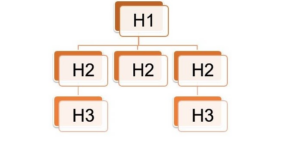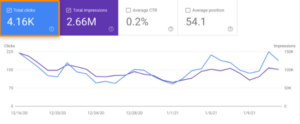While on-page optimization is more complicated than it was a while ago, it’s still the simplest part when it comes to SEO . It’s one of those few things that you have total control over, and that doesn’t require excessive technical preparation. If you know how to make basic changes to a site, write (or know someone who can) and are willing to do some research, that’s it.
Let’s start.
First let’s clarify what on-page SEO is and why it’s important.
What is On Page SEO?
” SEO On Page ” is the name used to indicate the optimization that can be done directly on the pages of the site that you are trying to position in the Google results. Put simply, it represents everything you can change on your site to try and get it to come first in Google’s search results.
Why is on-page SEO important?
Google analyzes the content of your page to understand whether or not it is a relevant result for a particular search. Part of this process is to identify keywords.
But there’s more than just including keywords in your content when it comes to on-page SEO — much more.
Google is looking for the most relevant result to a specific query, so their algorithms are always looking for relevant content within the page. If you talk about dogs and don’t name the various breeds, Google knows there are probably more relevant results out there on the web than yours.
Relevance is a big part of on-page SEO , and if you don’t understand it, it will be difficult to position yourself.
The basic SEO guidelines for content
The contents within a site can be categorized for four types of research:
- Transactional: The user wants to buy a product and explicitly types the name and model in the search.
- Informative: the user performs a general search for a future purchase (for example “the best running shoes”).
- Navigation: this type of search helps the user to reach a specific site
- Local: The search is done to find a physical location. For example, it can be used to search for shops to find contact information such as phone number or location.

Identify topics, keywords and related
The first step is to identify the content you want to write. To get inspiration and identify the keywords that are right for you, it is good to carry out a quick competition analysis for the same theme you intend to develop. To achieve your goal, that is to earn the top positions of the SERP, it is good to analyze the work of the “best”, or those sites that are currently on the first page of Google search results for the search you are interested in.
Within the article, one or two keywords (keywords) will be identified, which will fully reflect the subject matter. In addition to keywords, it will be necessary to select semantically related words (synonyms, words relevant to the topic, etc.). This search can be carried out using different tools such as Google Keyword Planner and Google Trends, which allow you to outline the number of searches for a specific word (search volume), the relevance of the keyword based on the topic and the relevance between the keyword and your business goal.
Define Title and Meta Description
The title tag is an HTML element that identifies the title of a page. This title must contain the selected keywords and, if possible, have a maximum length of 65 characters (about 6 to 12 words) to prevent Google from truncating it in the preview in the SERP.
If this is not possible, make sure that the non-truncated part is clear and effective.
The title tag is the title that users see in search results so it is good to create a captivating and clear title to understand, in order to pique their curiosity. The title must be unique for each page and must clearly define the content that will be read. If you want to split your title into two sections, we suggest using symbols such as the pipe or vertical bar (|) or the dash (-). For example: “SEO guide for beginners: the basic concepts you need to know – AvantGrade”
The meta description is an HTML element that provides a brief explanation of the on-page content that can appear in the Google SERP under the title tag. In addition to keywords, the description should preferably also contain previously selected related words or closely related synonyms. Currently Google does not set limits on the length of the Meta Description but, depending on the need, the text could be cut in the SERp and thus lose its meaning. Our advice is to insert the most important information in the first 150 characters. If you want to add more information, we recommend not to exceed 320 characters.
The structure of the contents and the hierarchy of the Headings
The proposed content must be fresh, authentic and of high quality. Based on the selected topic, it is advisable to analyze who is awarded today by Google (the first results that appear in the SERP) and to write content with a very similar depth (remember that the length itself is not an SEO factor ). The keywords and related words must be present in the body of the text, which must be original and declined according to the target that will read it. If, for example, your goal is to make SEOs understood by a novice audience, we could probably use simple language, while if we address the same topic with an expert audience we could allow ourselves to use more specific terms.
Regarding the structure, the main title will be identified with the tag heading H1. This gives a strong indication of the SEO side of what the page is about. The heading H1 tag must be clear and contain the previously selected keywords within it. If the page contains more sections or subsections, it is possible to insert a “hierarchy” of heading tags:
- H1 main title (within a page there must be only one!)
- H2 main section titles
- H3 titles of subsections
- H4 to H6 titles following subsections (this level of headings is hardly used unless you are writing a very long text)

Use SEO friendly URLs
As they say, it’s the first impression that matters.
Although its ranking value is relative, the URL is one of the first factors that will be seen by both Google and users and for this reason it is necessary to give it the importance it deserves. The URL, for the uninitiated, is a text string that identifies the address of a particular resource on the web.
To create SEO friendly URLs, that is, that search engines like, we recommend reading our guide on how to optimize URLs for SEO . We also suggest that you plan the structure of your URLs in advance as it might be convenient for you to carry out maintenance activities at a later time.
The URL of the page must maintain a standard format: to avoid being “spammy” and since spaces are not allowed within the URL, it is strongly recommended to use dashes (-) to separate words in the inside the link and the use of underscores or underscores (_) or other graphic signs is not recommended.
The importance of internal and external links

The insertion of links (internal and external that have the purpose of directing the reader to further information) within the content turns out to be a winning detail to transfer value to the page. It is important to pay attention to two factors:
Select the landing page
The landing page can be internal or external to the site, the important thing is to select a high quality link, useful to provide more relevant information to the reader. For example, the link could lead to a generic page such as the contact form or request for a quote or to a page that offers a more in-depth explanation of a particular topic. Normally, links to other pages on the same site open in the same window, while links to external sites open in a new window or new tab.
Choice of keywords on which to insert the link (anchor text)
When inserting a link it is always advisable to “anchor” it to one or more words. The choice of anchor text will need to be made so that it is relevant to the landing page. For example, if we are talking about Italian cuisine and in a paragraph we deepen the history of spaghetti with tomato sauce, we can give our readers the recipe to make this dish with a link: the word that best lends itself as an anchor text in this case is ” spaghetti with tomato sauce ”or“ spaghetti with tomato recipe ”. We recommend avoiding anchor text such as “click here”, “learn more here” and avoid using anchor text that is too similar to the keywords you want to rank for. The risk of over-optimization is around the corner.
The links are not all the same: usually the most used links are the dofollow links as they are able to transfer SEO value to the linked page.
Optimize images
Images can rank in Google Images and get you traffic. For example, over the last 28 days Ahrefs’ have received over 4,000 visits to our blog thanks to images.

Here is a quick 3-point checklist for optimizing your images.
a) Rename images sensibly
Google says the filename gives them information about the subject of the image, so dog.jpg is better than IMG_859045 .jpg.
Unfortunately, most smartphones and cameras use generic names for photos and images. And the same goes for computers. If you take screenshots to include in your article, they will usually be renamed something like Screenshot 2021-01-12.png.
For this reason you should rename them. That’s how:
- Try to be descriptive . puppy-black.jpg> puppy.jpg
- Be succinct . black-puppy.jpg> my-super-black-puppy-called-jeff.jpg
- Don’t abuse keywords . black-puppy.jpg> black-puppy-dog-breed-pooch.jpg
- Use hyphens between words . puppy-black.jpg> puppy_nero.jpg (this is an official Google recommendation )
b) Use descriptive alt text
Alt text (alternative text) is an HTML attribute that is used on <img> tags to describe the image. It is not visible directly on the page, and is applied like this:
The main purpose of alt text is to improve accessibility for visitors using a screen reader. These convert the page content, including images, to audio. Browsers also show alt text instead of images if they can’t load them.
When creating alt text, Google recommends that you ‘focus on creating useful, information-rich content that uses keywords in the right way and is contextual to the page content’. But they also recommend avoiding stuffing the alt attribute with too many keywords (keyword stuffing) as it negatively impacts user experience.
That said, here are our tips for creating an alt text:
- Be descriptive. Use relevant keywords when appropriate.
- Try to be concise . Be brief to avoid annoying users of screen readers.
- Be thorough. Describe the content of the images.
- Avoid keyword stuffing. It can ‘make your site look like spam’.
- Don’t say it’s an image. Don’t include things like “picture of …” or “picture of …” in your descriptions. Both Google and screen readers know it’s an image.
If you are a WordPress user, you can easily add alt text to images when inserting them into posts.
c) Compress the images
Compressing images makes file sizes smaller, leading to faster loading times. This is important, as loading speed is a ranking factor on both desktop and mobile .
There are many tools for compressing images, but ShortPixel is the one we prefer. It has a web interface where you can compress up to 50 images at a time for free and a WordPress plugin that compresses images automatically when uploaded.
You can compress up to 100 images per month with the free version of ShortPixel, after which for a few fractions of a cent the following.
Advanced SEO Optimizations
Everything we’ve covered so far is enough to optimize your pages properly, but there are another set of things you can do. If you already have well-positioned content and want to give it an extra push to position it even better, or obsessively refine yours on-page SEO
1. Optimize for featured snippets
Featured snippets are a SERP feature that is often shown at the top of search results. They answer the question of those who search with a short excerpt from one of the best positioned pages.
An example of a featured snippet for “what are local citations” (or “what are local citations” in English).
Since the snippet responses come from one of the search results pages, it is possible to ‘win’ them by then using them as a shortcut to reach the top of the page.
Doing so is simpler than saying it, and the process is as follows:
- You must be in the top 10. Google usually fetches the snippet content from one of these pages.
- Make sure Google already shows a featured snippet. You will use this to your advantage to understand how to ‘respond’ to the search.
- Provide the answer on your page. Google cannot extract information from your page if it is not present.
- Use the right format. Paragraphs, lists or tables — what do they expect Google to see and who are they looking for?
For example, let’s say we want to explore the possibilities of grabbing some featured snippets for one of our articles about evergreen content. If we enter the URL into Ahrefs’ Site Explorer , filter the Organic Keywords report for the keywords for which we are in the top 10, we can see that we are already in the top 10 for the keyword ‘evergreen content’ ( or “evergreen content” in English).
Our positioning for the keyword “evergreen content” (or “evergreen content” in English), through data from Ahrefs’ Site Explorer .
If we check the SERP , we can see that the current featured snippet is a short paragraph with a definition of the term.
The definition within the featured snippet for “evergreen content” (or “evergreen content” in English).
In order to be able to appear in this featured snippet, we need a definition within our page.
But if, for example, we had wanted to win the snippet for ‘most visited websites’ (or “most viewed websites” in English), we would probably have had to include a table containing the highest searches and their relative volumes.
The table within the featured snippet for “most viewed websites” (or “most viewed websites” in English) “
2. Incorporate resources that attract links
Links remain one of the most important ranking factors for Google. And although link building is part of SEO off-page , you can try to attract some by making your page content easy for others to link to.
How do you know if a particular topic attracts links from other sites or not?
Just analyze the reasons why people link to similar content proposed by your competitors.
For example, the main keyword in one of our articles is “long tail keywords”. If we insert this keyword into Ahrefs’ Keyword Explorer , we can see how there are some similar articles that receive many backlinks.
Site positions for long tail keywords in the United States, taken from Ahrefs’ Keywords Explorer .
Let’s insert one of these articles in the Site Explorer and analyze the report called Anchors . This shows us the words and phrases people use most when they link to that page. In this case, we can see that people create the links because they are interested in the proposed statistics.
The Anchors report within Ahrefs’ Site Explorer .
This tells us that we should probably include some statistics to make the page more ‘link grabbing’.
If we take another example and check the Anchors report for one of the best positioned pages for ” SEO copywriting”, we can see how people link to that page mainly for two concepts it contains.
It probably wouldn’t make sense for us to include these same concepts in our article, but we can include some unique ideas to improve your chances of getting links. This is exactly what we did when we wrote our SEO copywriting guide .
3. Get rich snippets using Schema markup
Rich snippets are results that contain additional information beyond the title, description, and URL .
For example, Google shows the grades, cooking times, and calories for these recipe pages.
Google extracts this information thanks to a type of structured data on the page called Schema markup. In this specific case, the pages have incorporated schema markup for recipes .
Here are other types of Schema markup that can lead to rich snippets:
- Instruction markup
- Product Markup
- Reviews markup
- Software Markup
- FAQ markup
Here is an example of a page within the SERPs that makes use of FAQ markup :
Rich snippet FAQ
Rich snippets aren’t a ranking factor , but many believe they help get more clicks — at least for some pages.
If you use WordPress, you can add Schema markup to pages and posts using some plugins like Yoast and RankMath. However, you should be aware that not all types of content are accepted for search improvements such as rich snippets.
4. Improve the relevance of the topic
Google considers a page more relevant to a specific search query if it ‘contains other relevant content besides the keyword’. For example, if your page is about dogs, having a list of the various breeds in it could make it more online for someone looking for ‘dogs’.
If you’ve followed the advice in chapter two of this guide, your content should already have many relevant words, phrases, and concepts in it. This is because we tend to insert them naturally as you write.
But it’s easy to lose some concepts along the way — especially on more complex topics.
For example, this is one of the best positioned pages for ‘how to brew beer’. It is a rather understanding guide for beginners, but it forgets to mention that you will need a siphon to transfer the beer from the fermenter to the bottles.
A page on how to produce beer that does not have important details inside.
If this is also the case, you are probably not positioned as you would like and you are not even sure why. It therefore makes sense to thoroughly analyze the page to see if there is any missing information.
Here are some ways to do it best.
Use the ‘Also talk about’ report
The ‘Also talk about’ report within the Keyword Explorer , shows the keywords and phrases frequently mentioned by the pages positioned in the top 100. Enter the main keyword and see in one fell swoop which topics are best covered by the pages. positioned.
For example, returning to our case of ‘how to brew beer’, we can see how many of the keywords identified are ingredients or equipment:
- hop
- yeast
- malted barley
- malt extract
- wort cooler
- mashing vessel
- automatic siphon
The topics touched on by the pages that are positioned for “how to brew beer” (or “how to brew beer” in English) taken from the Keywords Explorer .
Since an aspiring master brewer needs to know what most of these things are and what they are for, it’s worth talking about in your guide on how to brew beer for beginners. If you forgot to mention some of these things, it’s best to freshen up your content.
You must use common sense when doing this. The fact that a word or phrase appears in the ‘also talk about’ report does not mean that you necessarily have to include it. Use the report to identify any important concepts you haven’t covered.
Do a TF-IDF analysis
TF-IDF is a term that stands for Term Frequency-Inverse Document Frequency. It is a statistical measurement that aims to judge the importance of a word in a document. This value is obtained by comparing how often a word appears in that document to others.
Doing a TF-IDF analysis between your content and the best positioned ones can sometimes allow you to discover important concepts present on other pages but which you have forgotten about.
For example, if we do this for our article about negative SEO , we can see how our competitors’ pages are talking about the disavow file and unnatural links.
The idea here is not to ‘junk’ these keywords into your content, but rather to cover important concepts and ideas that you haven’t talked about. This way you can update your page to create more comprehensive and complete content.
TF-IDF analysis tools often prompt you to use the ‘important’ words and phrases a specific number of times. This is not the way we recommend using them.

WHAT ARE LSI KEYWORDS
The popular ‘ LSI keyword’ tools have nothing to do with LSIs , and it is unclear how they generate their recommended keywords. Sure they can provide interesting insights and ideas in some circumstances, but their advice is hardly useful in my experience.
To conclude
Follow the advice above, and your pages will likely be better optimized than those of your competitors. Remember to satisfy users’ search intent – this is the most important and critical part of all. The more ‘technical’ things are also important, but they are more of a kind of extra.





